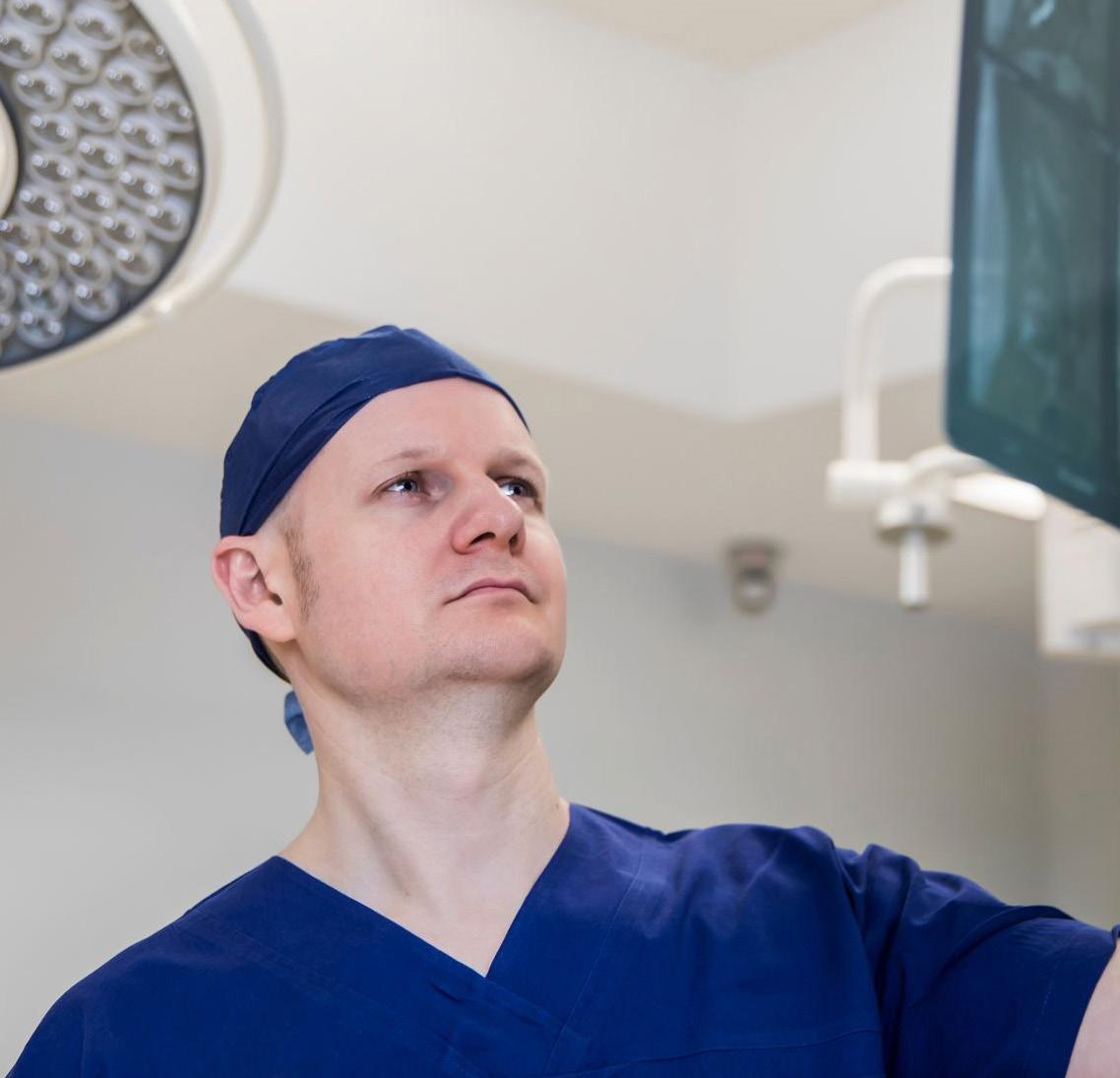
8 minute read
BRAINSPINE
NECK AND BACK PAIN

Advertisement

Neck and back pain can range from mild, annoying aches to severe, disabling pain
While most spine pain occurs as a part of the normal degenerative ageing process-it can also be a warning sign of cancer, infection, autoimmune disease, or a structural problem causing pressure on the spinal cord/ nerves
WHY DOES THIS OCCUR?
Our spines are comprised of a number of joints around the spinal cord and nerves. As we age, changes occur as the joints wear out resulting in inflammatory processes such as osteoarthritis. The joints and tissues can also become overgrown and compress a neural structure, which is called spinal stenosis. Failure of the joints to hold the bones in position can result in slippage and deformity. These are common characteristics of conditions such as spondylolisthesis, kyphosis, or scoliosis.
WHAT SYMPTOMS CAN THESE DEGENERATIVE CHANGES CAUSE?
• Dull, burning, or sharp pain-which can be confined to a single spot or cover a large area.
• Arm/leg numbness or tingling • Sharp, shooting pain that radiates from your neck and your arm. • Sharp shooting pain that radiates from your lower back to your buttocks, and down your leg (sciatica) • Stiffness in your neck or back • Difficulties with walking and balance • Difficulties with coordination • Loss of bladder and bowel control, with weakness in both legs are important symptoms that require immediate medical attention.
HOW IS A DIAGNOSIS MADE?
You should see your general practitioner for a medical and physical exam. They may obtain a CT scan and /or an MRI scan to assess your spine. CT/MRI produces pictures of bones, joints, ligament, the spinal cord and spinal nerves. Sometimes other tests are needed such as bone scans and specialised x-rays.
HOW ARE BACK AND NECK PAIN TREATED?
If you experience back or neck pain it may simply improve with some rest. Over the counter medicines such as paracetamol or ibuprofen, may also help alleviate discomfort. Activity should be modified to avoid movement that exacerbates pain. Physiotherapy, acupuncture, and massage therapy are beneficial. Low-impact exercise programs may improve range of motion, increase muscle strength, and improve flexibility and mobility, increase endurance, and improve pain. Weight loss and improving one’s core strength are also useful.
WHEN CAN A SURGEON HELP?
A surgeon can advise on further treatment if the above suggestions haven’t improved the pain and your quality of life. Your surgeon can assess your imaging and recommend cortisone steroid injections that can alleviate some forms of neck, back, arm or leg pain. An appropriate surgical operation can also significantly improve pain, mobility and quality of life.
WHAT DOES AN OPERATION INVOLVE?
Because symptoms, imaging findings and causative factors can vary significantly, a surgical procedure must be tailored for you. A traditional spine surgery procedure involves an incision along the backbone. The surgeon moves muscle and soft tissue aside to gain access to the bones of the spine and the spinal cord. Minimally invasive techniques involve a smaller incision and special microsurgical instruments, through which the surgeon operates on the spine. Minimally invasive techniques may be able to shorten recovery time and reduce the risk of complications. These approaches allow the surgeon to trim away overgrown bone, ligament and joint tissue to decompress the spinal cord and spinal nerve. Some operations (for example those that help control the conditions spinal stenosis or sciatica) employ a decompression technique and at times may also require a fusion. The latter involves a surgeon placing titanium screws and rods to stabilise the spine and cause adjacent vertebrae to fuse. There are minimally invasive ways to perform this type of surgery, and can even encompass advanced technology such as GPS-like tracking systems and robotics. If performed for the right indications, surgery can be effective in 80-90% of patients.
WHAT HAPPENS AFTER SURGERY
Most patients are mobilised either on the same or following day of surgery, as early movement has been shown to be be beneficial. You may be reviewed by a physiotherapist to provide advice on stretches, exercises and activities. Sometimes health professionals will design a rehabilitation program to meet your needs. The type of program will depend on the procedure you underwent and your level of mobility. The goal of back and neck rehabilitation is to help you return to your highest level of fitness and independence and improve your overall quality of life. Courtesy Dr Raj Reddy, MBBS, MS, FRACS

Dr Raj Reddy is a neurosurgeon with special interests in complex & minimally invasive spine surgery, paediatric neurosurgery, and brain tumour surgery.
Raj manages all neurosurgical conditions, both cranial and spinal. He has a special interest in spine surgery, with foci on minimally invasive techniques as well as complex reconstructive surgery. The focus of his cranial surgery is in the management of intracranial tumours, trauma , and craniofacial operations; both adults and paediatric patients Suite 3, Level 7
Prince of Wales Private Hospital

Dr Raj Reddy, MBBS, MS, FRACS
Dr Peter Wilson is a specialist neurosurgeon with a focus on endoscopic skull base surgery, complex spinal surgery and cranial / spinal tumour surgery.
Peter is committed to maintaining the highest level of clinical and operative care of his patients, and is constantly striving to improve his practice by perpetually evolving in pace with the latest in medical advancements. His clinical interests include: • Pituitary disease • Trigeminal neuralgia / hemifacial spasm • Spinal sagittal balance • Benign and malignant brain tumours Suite 3, Level 7
Prince of Wales Private Hospital

Dr Peter Wilson BSc MB BS (Hons) MS MSurg FRACS (Neuro)

DR PETER WILSON
BSc MB BS (Hons) MS MSurg FRACS
BOWLING & LIFESTYLE MAGAZINE recently had the privilege of chatting with neurosurgeon Doctor Peter Wilson from BRAINSPINE, about his extraordinary career, his family and private life away from the surgery and the legacy he wants to leave behind.
BRAINSPINE’S specialist neurosurgeon DR. PETER WILSON’s focus is on endoscopic skull base surgery, brain tumour surgery, and complex spinal surgery. His current appointments are at Prince of Wales Public and Private Hospitals, and St Vincent’s Private Hospital in Sydney. Peter graduated from the University of Sydney in 2005 and has worked in multiple neurosurgical units as a registrar, training with over 30 neurosurgeons before completing his formal training in 2015. During his training, he completed a Masters of Surgery by research at the University of New South Wales and a Master of Surgery at Macquarie University. After concluding his neurosurgical training, Peter worked as a locum consultant neurosurgeon at the Prince of Wales Public Hospital prior to embarking on post-fellowship training. He then subsequently completed a complex spinal fellowship in Adelaide focusing on trauma, correction of spinal deformity and minimally invasive spinal surgery. He also travelled to Birmingham in the UK for further experience in skull base surgery and radiosurgery, as well as New York in the USA specifically for endoscopic skull base surgery. He is committed to maintaining the highest level of clinical and operative care of his patients, and is constantly striving to improve his practice by perpetually evolving in pace with the latest in medical advancements.
Q & A WITH DR. PETER WILSON
B&L : Congratulations Peter on your extraordinary career. What position do you currently occupy at The Prince of Wales Hospital? PETER : I am currently a consultant neurosurgeon. B&L : Why did you become a neurosurgeon, and are other family members in the medical profession? PETER : Yes both my parents are doctors, and I became a neurosurgeon because I have always been fascinated by the way our bodies work, especially the nervous system. I also find it extremely rewarding helping vulnerable people overcome complex situations, associated with brain and spinal surgery. B&L : How long have you been associated with BrainSpine? PETER : I joined BrainSpine in 2016, after I returned from the the United States, where I was fortunate to learn from Dr. Theodore Schwartz, who is a world leader in endoscopic skull base surgery at Weill Cornell Medicine in New York. B&L : What are the benefits of belonging to the BrainSpine team? PETER : There are many benefits associated with belonging to the BrainSpine Team, the main one being, all the neurosurgeons involved are dedicated to maintaining the highest level of clinical and operative care for their patients. Subsequently we all get on well and are supportive of each other. It is a very comfortable environment. B&L : What was your second option, if you were not successful in this field? PETER : I would have become a scientist. B&L : Are you married and how does your wife/partner deal with your work commitments and long hours? PETER : Yes I am married and have two children, my wife is supportive and understands my work commitments. B&L : What is your advice for a healthy mind and body? PETER : A healthy diet with lots of vegetables, and consistency when exercising. B&L : How do you relax when you are at home? PETER : Home is very intense because I have a 6 year old and a 2 year old. I relax by being at work and focusing intensely on one task at a time. B&L : How do you feel about COVID, and do you think the Government has dealt with COVID correctly, is there anything you would have done differently? PETER : Yes I would have done a few things differently, however compared to other countries, I think Australia is doing very well. B&L : What are your aspirations for the future and what legacy do you want to leave behind? PETER : Maintain my focus to maximise the positive outcomes for my patients, and continue to teach the next generation of budding neurosurgeons.








